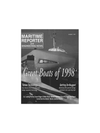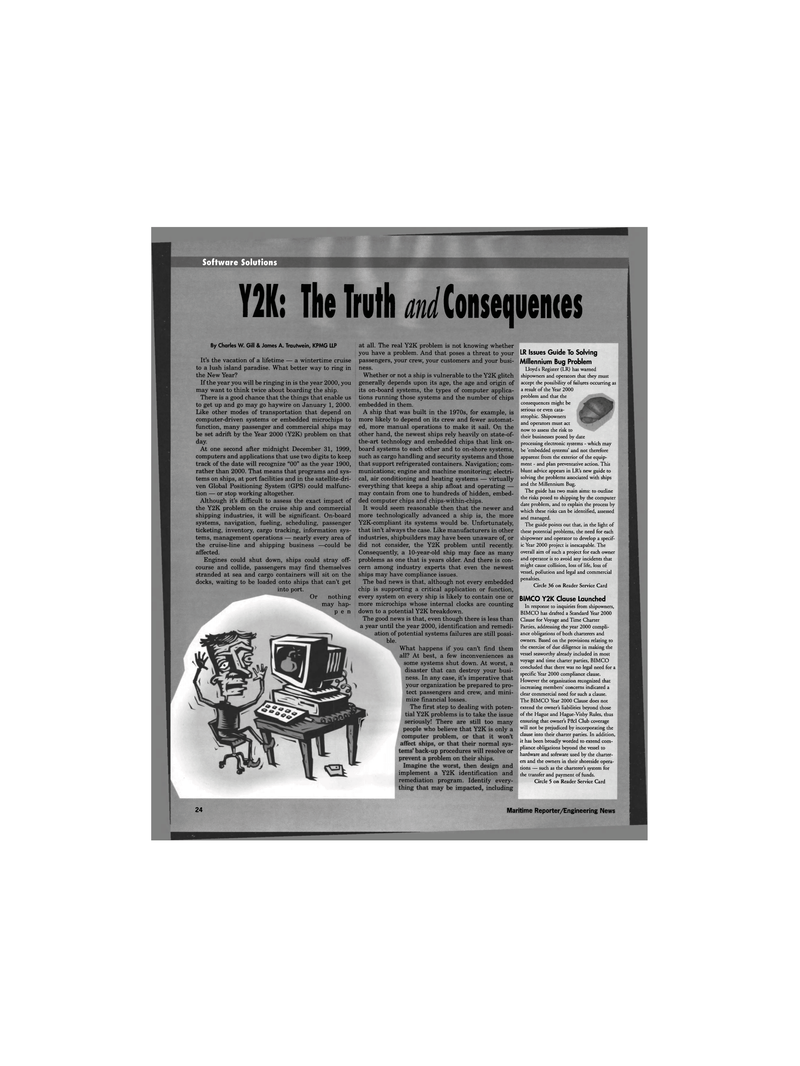
Page 24: of Maritime Reporter Magazine (January 1999)
Read this page in Pdf, Flash or Html5 edition of January 1999 Maritime Reporter Magazine
Software Solutions
Y2K: The Truth W Consequents
By Charles W. Gill & James A. Trautwein, KPMG LLP
It's the vacation of a lifetime — a wintertime cruise to a lush island paradise. What better way to ring in the New Year?
If the year you will be ringing in is the year 2000, you may want to think twice about boarding the ship.
There is a good chance that the things that enable us to get up and go may go haywire on January 1, 2000.
Like other modes of transportation that depend on computer-driven systems or embedded microchips to function, many passenger and commercial ships may be set adrift by the Year 2000 (Y2K) problem on that day.
At one second after midnight December 31, 1999, computers and applications that use two digits to keep track of the date will recognize "00" as the year 1900, rather than 2000. That means that programs and sys- tems on ships, at port facilities and in the satellite-dri- ven Global Positioning System (GPS) could malfunc- tion — or stop working altogether.
Although it's difficult to assess the exact impact of the Y2K problem on the cruise ship and commercial shipping industries, it will be significant. On-board systems, navigation, fueling, scheduling, passenger ticketing, inventory, cargo tracking, information sys- tems, management operations — nearly every area of the cruise-line and shipping business —could be affected.
Engines could shut down, ships could stray off- course and collide, passengers may find themselves stranded at sea and cargo containers will sit on the docks, waiting to be loaded onto ships that can't get into port.
Or nothing may hap- p e n at all. The real Y2K problem is not knowing whether you have a problem. And that poses a threat to your passengers, your crew, your customers and your busi- ness.
Whether or not a ship is vulnerable to the Y2K glitch generally depends upon its age, the age and origin of its on-board systems, the types of computer applica- tions running those systems and the number of chips embedded in them.
A ship that was built in the 1970s, for example, is more likely to depend on its crew and fewer automat- ed, more manual operations to make it sail. On the other hand, the newest ships rely heavily on state-of- the-art technology and embedded chips that link on- board systems to each other and to on-shore systems, such as cargo handling and security systems and those that support refrigerated containers. Navigation; com- munications; engine and machine monitoring; electri- cal, air conditioning and heating systems — virtually everything that keeps a ship afloat and operating — may contain from one to hundreds of hidden, embed- ded computer chips and chips-within-chips.
It would seem reasonable then that the newer and more technologically advanced a ship is, the more
Y2K-compliant its systems would be. Unfortunately, that isn't always the case. Like manufacturers in other industries, shipbuilders may have been unaware of, or did not consider, the Y2K problem until recently.
Consequently, a 10-year-old ship may face as many problems as one that is years older. And there is con- cern among industry experts that even the newest ships may have compliance issues.
The bad news is that, although not every embedded chip is supporting a critical application or function, every system on every ship is likely to contain one or more microchips whose internal clocks are counting down to a potential Y2K breakdown.
The good news is that, even though there is less than a year until the year 2000, identification and remedi- ation of potential systems failures are still possi- ble.
What happens if you can't find them all? At best, a few inconveniences as some systems shut down. At worst, a disaster that can destroy your busi- ness. In any case, it's imperative that your organization be prepared to pro- tect passengers and crew, and mini- mize financial losses.
The first step to dealing with poten- tial Y2K problems is to take the issue (f seriously! There are still too many people who believe that Y2K is only a computer problem, or that it won't affect ships, or that their normal sys- tems' back-up procedures will resolve or prevent a problem on their ships.
Imagine the worst, then design and implement a Y2K identification and remediation program. Identify every- thing that may be impacted, including
LR Issues Guide To Solving
Millennium Bug Problem
Lloyds Register (LR) has warned shipowners and operators that they must accept the possibility of failures occurring as a result of the Year 2000 ! problem and that the consequences might be serious or even cata- strophic. Shipowners and operators must act now to assess the risk to i their businesses posed by date ' processing electronic systems - which may be 'embedded systems' and not therefore apparent from the exterior of the equip- ; ment - and plan preventative action. This blunt advice appears in LR's new guide to solving the problems associated with ships and the Millennium Bug.
The guide has two main aims: to outline • the risks posed to shipping by the computer date problem, and to explain the process by which these risks can be identified, assessed and managed.
The guide points out that, in the light of these potential problems, the need for each : shipowner and operator to develop a specif- ic Year 2000 project is inescapable. The overall aim of such a project for each owner and operator is to avoid any incidents that might cause collision, loss of life, loss of vessel, pollution and legal and commercial penalties.
Circle 36 on Reader Service Card
BIMCO Y2K Clause Launched
In response to inquiries from shipowners,
BIMCO has drafted a Standard Year 2000
Clause for Voyage and Time Charter
Parties, addressing the year 2000 compli- ance obligations of both charterers and owners. Based on the provisions relating to the exercise of due diligence in making the vessel seaworthy already included in most voyage and time charter parties, BIMCO concluded that there was no legal need for a specific Year 2000 compliance clause.
However the organization recognized that increasing members' concerns indicated a clear commercial need for such a clause.
The BIMCO Year 2000 Clause does not extend the owner's liabilities beyond those of the Hague and Hague-Visby Rules, thus ensuring that owner's P&I Club coverage will not be prejudiced by incorporating the clause into their charter parties. In addition, ; it has been broadly worded to extend com- i pliance obligations beyond the vessel to hardware and software used by the charter- ers and the owners in their shoreside opera- tions — such as the charterer's system for the transfer and payment of funds.
Circle 5 on Reader Service Card 24 Maritime Reporter/Engineering News

 23
23

 25
25
